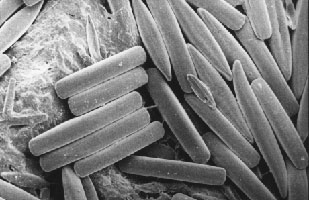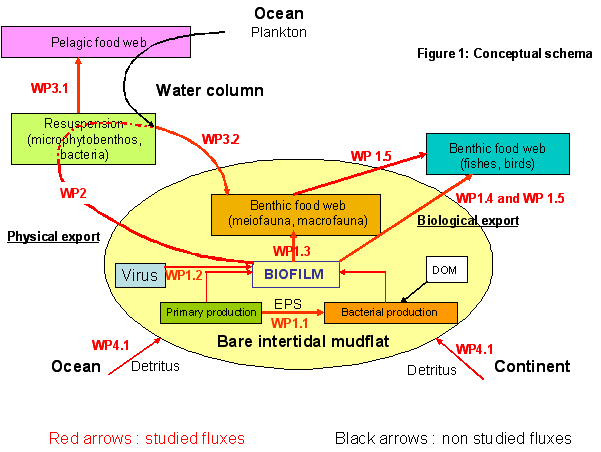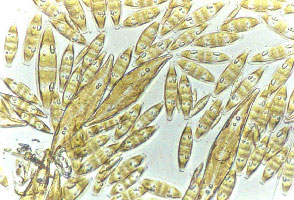| responsable : | ||
workpackage 1 : |
benthic food web | Christine Dupuy |
workpackage 2 : |
Benthic-pelagic coupling : biofilm erosion and resuspension of micro-organisms | Francis Orvain |
workpackage 3 : |
Pelagic food web | Hélène Montanié |
workpackage 4 : |
Fate of biofilm productions through stable isotope analysis | Pierre Richard |
workpackage 5 : |
Process integration through benthic-pelagic modeling | Katell Guizien |
Il ressortira ainsi de ce projet une compréhension du fonctionnement et une quantification précise des processus suivants :
- la production bactérienne associée aux ExoPolysaccharides du biofilm microalgal,
- son contrôle par les virus,
- la consommation du biofilm (bactérivorie et l’herbivorie) par les organismes benthiques déposivores,
- idem par les vecteurs biotiques vertébrés (poissons et oiseaux),
- l’érosion et la remise en suspension du biofilm,
- la consommation/infection des bactéries et diatomées remises en suspension dans le réseau planctonique,
- leur consommation par les suspensivores benthiques.
- un modèle dynamique d’écosystème couplant les processus trophiques et de production à ceux de la remise en suspension et du transport par advection,
- un modèle statique des flux dont la caractérisation par des indices globaux permettra une approche plus large de comparaison inter écosystèmes.
 Project
Synopsis
Project
Synopsis
Tidal flats represent a key system in the tightly connected network
of ecosystems at the continent – ocean interface. Biofilm forming
diatoms confer them a high productivity. Their functioning has been
described in several recent research programs. By contrast, relatively
little is known about the mode and fate of the bacterial production
associated with the detritic organic matter and the ExoPolySaccharide
(EPS) exudation in the tidal flat biofilms. Preliminary studies show
that the bacterial production is at least as high as the microalgal
production. For an integration of the ecological functioning of tidal
flat systems into a global carbon fluxe scheme, it is necessary to
describe and quantify how this bacterial production is determined and
what is it becoming in the ecosystem.
To do so, physical and ecological studies must be associated, and laboratory,
field and modeling approaches must be combined. Indeed, tidal water movements
are known to be essential in the determinism of the biofilm primary production
and in its resuspension. A physical study of resuspension and of advective
transport in the water column will be coupled with trophic process studies.
Likewise, the study of benthic and pelagic processes will be coupled since
the biofilm besides being consumed by benthic deposit feeders, is resuspended
and hence consumed as plankton by planktonic consumers and benthic suspension-feeders.
Trophic process estimations in both domains will be based on direct measures
of prey decline in incubation experiments as well as natural and prey-enrichment
tracer studies. Biotic vectors like birds and fishes will be included for
their potential role of exportation of the biofilm production to adjacent
areas. Physical and ecological data will be integrated in a multi model
approach with a combination of static and dynamic models of organic matter
flow.
As a result, the following processes will be quantified and their mechanisms
will be understood :
- bacterial production associated with the biofilm EPS,
- associated virus impact,
- biofilm consumption (bacterivy and herbivory) by benthic deposit feeders,
- biofilm consumption by biotic vectors (fish and birds),
- erosion and resuspension of the biofilm,
- consumption and viral infection of the resuspended bacteria and diatoms in the planktonic food web,
- their consumption by benthic suspension- feeders.
- 1) a dynamic model will integrate trophic processes, resuspension and advective transport,
- 2) a static model of the fluxes will allow a larger-scale inter-ecosystem comparison of the emergent properties.




